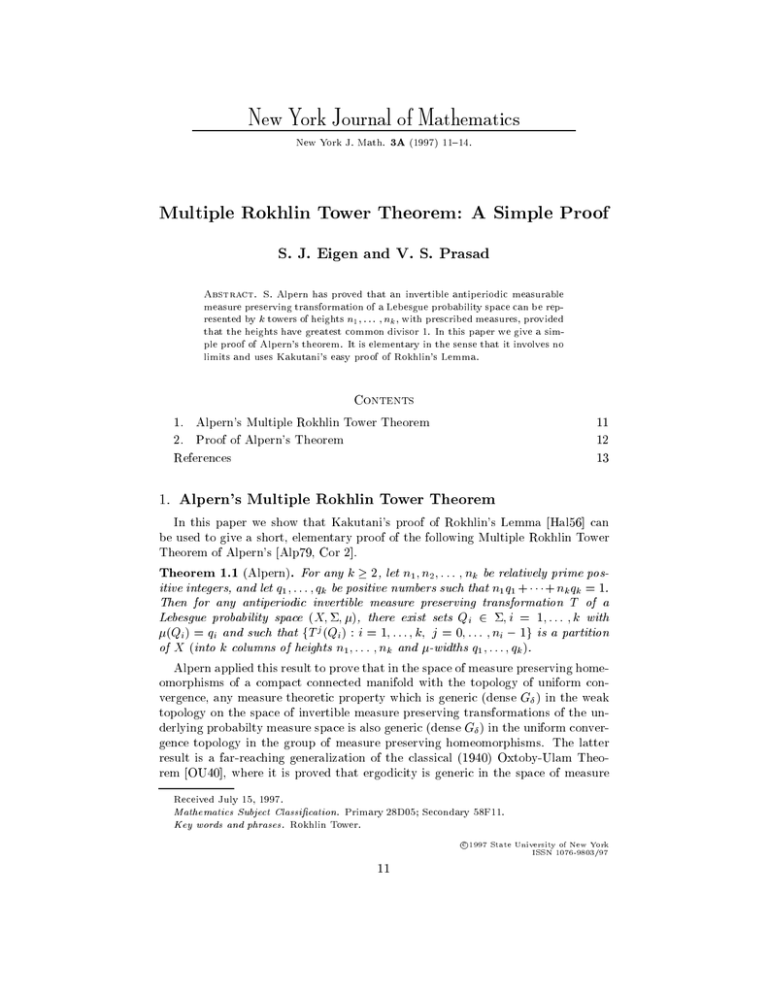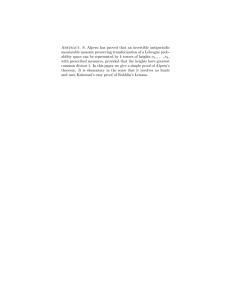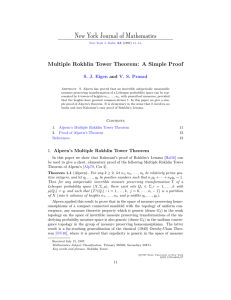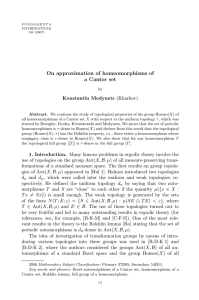Multiple Rokhlin Tower Theorem: A Simple Proof
advertisement

New York Journal of Mathematics
New York J. Math.
3A (1997) 11{14.
Multiple Rokhlin Tower Theorem: A Simple Proof
S. J. Eigen and V. S. Prasad
Abstract. S. Alpern has proved that an invertible antiperiodic measurable
measure preserving transformation of a Lebesgue probability space can be represented by towers of heights 1
k , with prescribed measures, provided
that the heights have greatest common divisor 1. In this paper we give a simple proof of Alpern's theorem. It is elementary in the sense that it involves no
limits and uses Kakutani's easy proof of Rokhlin's Lemma.
k
n ::: n
Contents
1. Alpern's Multiple Rokhlin Tower Theorem
2. Proof of Alpern's Theorem
References
1.
11
12
13
Alpern's Multiple Rokhlin Tower Theorem
In this paper we show that Kakutani's proof of Rokhlin's Lemma Hal56] can
be used to give a short, elementary proof of the following Multiple Rokhlin Tower
Theorem of Alpern's Alp79, Cor 2].
Theorem 1.1 (Alpern). For any k 2, let n1 n2 : : : nk be relatively prime positive integers, and let q1 : : : qk be positive numbers such that n1 q1 + + nk qk = 1.
Then for any antiperiodic invertible measure preserving transformation T of a
Lebesgue probability space (X ), there exist sets Qi 2 i = 1 : : : k with
(Qi ) = qi and such that fT j (Qi ) : i = 1 : : : k j = 0 : : : ni ; 1g is a partition
of X (into k columns of heights n1 : : : nk and -widths q1 : : : qk ).
Alpern applied this result to prove that in the space of measure preserving homeomorphisms of a compact connected manifold with the topology of uniform convergence, any measure theoretic property which is generic (dense G ) in the weak
topology on the space of invertible measure preserving transformations of the underlying probabilty measure space is also generic (dense G ) in the uniform convergence topology in the group of measure preserving homeomorphisms. The latter
result is a far-reaching generalization of the classical (1940) Oxtoby-Ulam Theorem OU40], where it is proved that ergodicity is generic in the space of measure
Received July 15, 1997.
Mathematics Subject Classication. Primary 28D05 Secondary 58F11.
Key words and phrases. Rokhlin Tower.
11
c 1997 State University of New York
ISSN 1076-9803/97
S. J. Eigen and V. S. Prasad
12
preserving homeomorphisms. Furthermore this contains Katok and Stepin's 1970
result KS70] that weak mixing is generic for measure preserving homeomorphisms.
Very recently, N. Ormes Orm] has used Alpern's Multiple Rokhlin Tower Theorem as one step in obtaining the following result about realizing an ergodic measure
preserving system as a minimal homeomorphism of the Cantor set within a given
topological orbit equivalence class: Let Y be a Cantor set, S a minimal homeomorphism of Y and a uniquely ergodic S -invariant Borel probability measure. Let T
be an ergodic invertible measure preserving transformation of the Lebesgue probability space (X ). Then there is a topological realization (S ) of the ergodic
system (T ), where S is a minimal homeomorphism of the Cantor set Y strongly
orbit equivalent to S if and only if the nite rotations which are topological factors
of S are measurable factors of T .
Two homeomorphisms, S and S , of the Cantor set Y , are said to be strongly
orbit equivalent if there is a homeomorphism h : Y ! Y and integer valued maps
m n : Y ! Z such that hS m(x)(x) = S h(x) hS (x) = (S )n(x) h(x) and m and
n have no more than one point of discontinuity. Strong orbit equivalence of two
minimal Cantor homeomorphisms has been identied in the work of Giordano,
Putnam and Skau GPS96, Theorem 2.2] as a necessary and sucient condition for
the isomorphism of the crossed product C -algebras (C (Y ) S Z , and C (Y ) S Z )
associated with the minimal homeomorphisms .
Multiple Rokhlin Towers arise naturally in the study of minimal homeomorphisms S of the Cantor set in the following manner. Given any clopen set A in the
Cantor set Y , consider rA : A ! N , the rst return time function to A for the homeomorphism S , where rA (x) is the smallest positive integer such that S rA (x) (x) 2 A.
Then the continuity of this function implies there is a nite set of positive integers
n1 : : : nk which is the range of rA . This gives a Multiple Rokhlin Tower partition
of Y into clopen sets (into k towers of heights n1 : : : nk over the base A). It is
this tower for S which Ormes \copies" for the ergodic T using Alpern's theorem.
While it need not be true that the gcdfn1 : : : nk g = 1, Ormes notes Orm, Cor
4.2] that if gcdfn1 : : : nk g = p, then there is periodic clopen set for S of period p.
Thus to have a similar tower picture for T , there must also be a T -periodic set in
X of order p.
Extensions of Alpern's Multiple Rokhlin Tower Theorem to denumerably many
columns and to nonsingular aperiodic transformations may be found in Alp81] and
AP90]. In addition applications of these extensions to coding Markov chains and
approximate conjugacy theorems can also be found in those papers.
0
0
0
0
2.
0
0
Proof of Alpern's Theorem
Step 1: Prescribing return times: We nd a set A X such that the set of rst
return times to A under T are exactly n1 : : : nk .
Proof Step 1: Since gcdfn1 : : : nk g = 1, let R be a positive integer such that
every integer r R, can be expressed as nonnegative integer multiples of n1 : : : nk .
Following Kakutani's easy proof of Rokhlin's Lemma, let E be a sweep out set
(i.e., X = i=0 T i (E )), such that the set of rst return times back to E are all greater
than R (in Step 2 we will require that E has small measure). This is elementary
in the case that T is ergodic. See Hal56] for a proof when T is antiperiodic. Write
1
Multiple Rokhlin Tower Theorem: A Simple Proof
13
E = m R Em , where Em = fx 2 E : the rst return time to E is mg. The column
i 1
of height m over E is the set C (Em ) = m
i=1 T Em .
For each m R write m = qN + r where R r < R + N and N = n1 n2 nk .
Then we can break up the column of height m over E , (C (Em )), into q new subcolumns of height N and one new subcolumn of height r as follows: The rst N
oors of C (Em ) are labeled (N 1) : : : (N N ), as are the next N oors. After
labeling the rst qN oors of C (Em ) into q many N -columns in this manner, the
last r oors are labelled to form an r-column (i.e, as (r 1) : : : (r r)). After doing
this for each m R and combining all of the new columns of the same height (i.e,
grouping all sets with the same label), we end up with one (large) column of height
N and at most N \remainder" columns of heights R R + 1 : : : R + N ; 1.
For each r, R r < R + N , since we can write r = r1 n1 + + rk nk where the ri
are nonnegative integers, we can break up each remainder r-column as follows: the
rst r1 n1 oors are broken up into r1 columns of height n1 the next block of r2 n2
oors are grouped into r2 columns of height n2 continuing, the last rk nk oors of
the r-column is broken into rk columns of height nk .
This partitions the space into a group of columns, one of height N and the others
of heights n1 : : : nk . The set A which is the base of these columns, has return times
N and n1 : : : nk . Note that the column of height N can be decomposed (labeled)
into as many columns of height n1 : : : nk as we wish, since N is a multiple of ni
for each i.
Step 2: Controlling the distribution: We note this has been a measure free construction thus far. If we wish to prescribe the distribution of the return times we
note that the total measure of the \remainder" columns of height r R r < R + N
is less than (R + N )(E ) where E was the base of the original skyscraper. By
choosing E small enough so that (R + N )(E ) < min fni qi : i = 1 : : : kg we can
guarantee that after breaking up the remainder columns of height r into columns
of heights n1 : : : nk no column of height ni has used up more than its \total
allowance" of measure ni qi .
Now partition the N -column into k disjoint vertical columns, one for each i =
1 : : : k, in the following manner: Suppose that the measure of the ni -column used
in paving all the \remainder" r-columns (R r < R + N ) totals up to pi . From the
column of height N we take a vertical strip of measure ni qi ; pi . Then this part of
the N -column is partitioned into columns of height ni . Choosing disjoint vertical
strips from the N -column for the dierent i's, the partition of X into columns of
height ni i = 1 : : : k, has the required distribution.
;
References
Alp79] S. Alpern, Generic properties of measure preserving homeomorphisms, Ergodic Theory,
Springer Lecture Notes in Mathematics 729 (1979) 16{27.
Alp81] S. Alpern, Return times and conjugates of an antiperiodic transformation, Ergodic Theory and Dynamical Systems 1 (1981) 135{143.
AP90] S. Alpern and V.S. Prasad, Return times of nonsingular transformations, Journal of
Mathematical Analysis and its Applications, 152 (1990) 470{487.
GPS96] T. Giordano, I. Putnam, and C. Skau, Topological orbit equivalence and -crossed
products, J. fur Reine. Angew. Math, 469 (1996) 51{110.
Hal56] P. Halmos, Lectures on Ergodic Theory, Publications of the Mathematical Society of
Japan, No. 3, Chelsea Publishing Company (1956).
C
S. J. Eigen and V. S. Prasad
14
KS70] A. Katok and A. Stepin, Metric properties of measure preserving homeomorphisms,
Uspekhi Mat. Nauk 25:2 (1970) 193{220. (Russian Math. Surveys 25 (1970) 191{220.)
Orm] N. Ormes, Strong orbit realization for minimal homeomorphisms, preprint.
OU40] J. C. Oxtoby and S. Ulam, Measure preserving homeomorphisms and metrical transitivity, Annals of Mathematics 2 (1940) 874{920.
Northeastern University, Boston MA 02115
eigen@neu.edu http://www.math.neu.edu/~eigen/
University of Massachusetts, Lowell MA 01854
vidhu prasad@uml.edu



